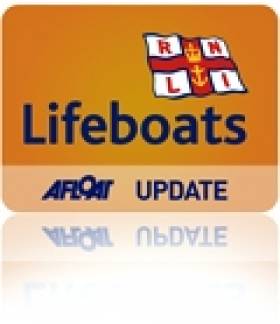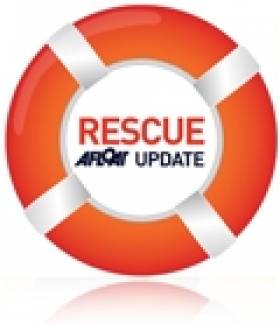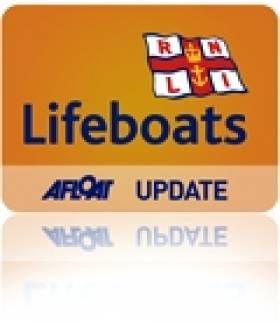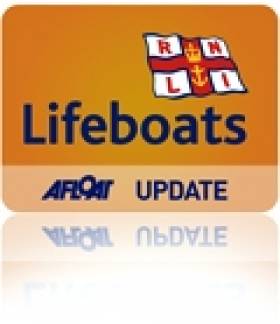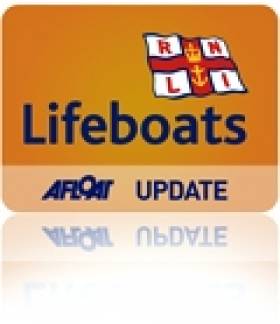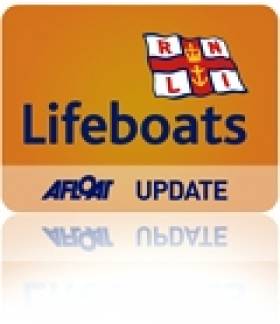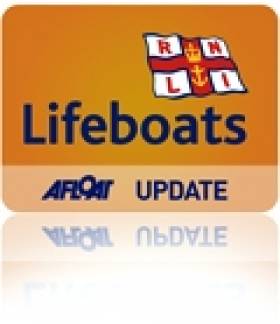Displaying items by tag: RNLI
#lifeboat – A brave Dun Laoghaire inshore lifeboat trio have been honoured with an RNLI award for a difficult rescue off Sandymount last year. Helmsman Rory Bolton along with Dan O'Sullivan and Damien Payne have received 'special recognition' and a framed Letter of Thanks.
As Afloat.ie reported at the time, the trio rescued a kitesurfer in hazardous weather off Sandymount when the person was unable to get ashore in dangerous surf conditions.
The D-Class Inshore lifeboat launched from the ILB Boathouse at Dun Laoghaire's East Pier on the morning of New Year's Day as winds gusted to Gale Force 8.
After assessing conditions on Dublin Bay, the lifeboat proceeded towards the Booterstown end of Sandymount Strand where the Dun Laoghaire Coast Guard Unit could see the casualty in the breaking surf. The kitesurfer was taken on board the lifeboat and reunited with his family back at the lifeboat station. Medical attention was not needed.
The Director of Operations for the RNLI George Rawlinson noted that the "poor visibility, gale force winds and rough seas of up to four metres" were particularly challenging.
Recovery of the casualty from the breaking surf required the best standards of helmsmanship by Rory Bolton. Excellent seamanship ensured a safe and effective operation at the limits of the ILB's capabilities.
The award was presented to Rory Bolton who accepted it on behalf of the crew by Owen Medland, Divisional Operations Manager at the lifeboat station in Dun Laoghaire.
The D-Class Inshore lifeboat (ILB) is a fast, fully-inflatable boat equipped with VHF Radio and electronic navigation as well as First Aid equipment. The D-Class at Dun Laoghaire performs around half of the station's annual call-outs. In 2014, Dun Laoghaire RNLI launched 56 times and brought 55 people to safety.
CH Marine Stage 'Lifejacket Awareness Week'
#lifejacketawareness – Inflatable Lifejackets are without doubt the most convenient and unobtrusive PFDs available but they do need regular checks and servicing for their safe operation when needs. Leading Lifejacket supplier CH Marine is holding a Life Jacket Awareness Week this week and offering information and guidance on the safe use and care of Gas Inflation Lifejackets. The RNLI are attending and, as well as daily tips ,special offers there are also chances to win some great lifejackets. Check out CH Marine Facebook Page for more.
#dinghycapsize – Volunteer lifeboat crew with Kilkeel RNLI launched yesterday evening at 6.30pm following reports of two people in the water off Killowen Point on Carlingford Lough. It is understood a member of the public raised the alarm on seeing two people in the water after their dinghies capsized.
Conditions at the time were choppy with a force four north westerly wind and good visibility. On arriving at the scene the lifeboat crew recovered the two exhausted casualties onto the lifeboat and took the two dinghies, which were drifting, under tow. The two were very cold but conscious. The lifeboat crew returned to Killowen Yacht club and was met by members of the South Down coastguard team and awaiting ambulance.
Commenting on the rescue John Fisher, Kilkeel RNLI said; 'This was a challenging callout for the lifeboat crew. The capsize happened near a sandbank and the lifeboat helm had to manoeuvre the lifeboat very carefully to safely recover the two people. The casualties were exhausted and very cold and our crew gave them warm blankets before returning them to shore.'
RNLI Launches 'H2Only' Challenge
#rnli – No tea. No coffee. No fizzy drinks. No wine. No beer. No orange juice. The RNLI is challenging people to give up all drinks except water for 10 days for the H2Only challenge to raise funds for the lifesaving charity.
Charlie Glynn from Kilrush RNLI is a helm at the Clare lifeboat station and he hopes that by undertaking the challenge that others might forego their beverages and stick to the water for the ten days.
The H2Only challenge runs from 5pm on Tuesday 2 June to 5pm on Friday 12 June, with participants giving up the drinks they love for 10 long days and drinking nothing but water throughout the challenge.
Commenting on the challenge Kilrush RNLI volunteer lifeboat crewmember Charlie Glynn said, 'The H2Only challenge is extremely tough. I know that going 10 days without a morning cup of tea or coffee, a drink after work or a can of fizzy drink will be really hard but I hope that people will also see it as a healthy thing to do as well as supporting a charity that spends so much time helping people in trouble on the water.
'Every euro raised is so important to the RNLI. As a charity, we rely on the support and generosity of the public so that we can continue to save lives at sea. Everything we have at our lifeboat station from the lifeboat, to our kit right through to our training, has been funded through people giving generously to the charity. I'd encourage people to sign up to take on the H2Only challenge. Please stay on the water for those tough 10 days to help us stay on the water.'
Everyone who signs up to take on the challenge will receive a pack containing H2Only temporary tattoos to proudly display. The tattoos, which have a seafaring theme, last up to 10 days – so participants can show off their exclusive H2Only 'ink' while taking on the tough challenge.
Participants will be able to download the free H2Only app from Google Play and the Apple App Store from Tuesday 26 May. The app is designed to make the 10 days fun, with daily challenges being set and pictures and videos from other H2Only participants being shared. The Apple version of the app is also compatible with the new Apple Watch.
During the same 10 day H2Only challenge period last year, RNLI lifeboat crews and lifeguards throughout Ireland and the UK saved 9 lives, with lifeboat crews launching 272 times and rescuing 289 people, while RNLI lifeguards attended 111 incidents and aided 189 people.
All those interested in taking on the challenge can sign-up now online at H2Only.org.uk.
#RNLI - Clifden RNLI carried out its first medical evacuation off Inishbofin island today (Thursday 21 May).
In what was the fourth callout this week for the station, the volunteer lifeboat crew was paged shortly after 11.30am following a report that a casualty required assistance.
The inshore Atlantic 85 lifeboat helmed by Bernard Whelan and the all-weather Mersey class lifeboat under coxswain John Mullan launched immediately and made their way to the scene. The Irish Coast Guard helicopter Rescue 115 from Shannon was also tasked.
Weather conditions at the time were foggy and visibility was poor. There was a Force 4-5 south westerly wind and a heavy swell.
The Atlantic 85 with crew members James Mullan, Daniel Whelan and Dermot Clancy onboard arrived on scene first. Mullan, a first aider with Clifden RNLI, went ashore and assisted the island nurse who was attending to the casualty.
When the all-weather lifeboat arrived at 1pm, the casualty was transferred to this lifeboat and brought to the mainland at Cleggan Pier where there was an ambulance waiting.
Speaking following the callout, Mullan said: "We have assisted with many medical evacuations in the past but today was the first time that our crew transported someone from Inishbofin island and brought them safely to the mainland.
"Both lifeboat crews worked well together today and we were happy to assist the island nurse in bringing this person to safety."
This was the fourth callout for Clifden RNLI this week. The crew assisted with two other medical evacuations and also went to the assistance of a yacht which got into difficulty on the shore.
#RNLI - RNLI lifeguards on the Causeway Coast helped to bring a sand dune fire under control at the weekend.
Lifeguards Jenny Thompson, Liam Mullan, James Walton and Jordan Burns were patrolling Benone Strand near Coleraine on Saturday afternoon (16 May) when, shortly after 3pm, they spotted smoke emerging from the sand dunes as they were preparing to enter the water to do some training.
One lifeguard went to investigate the incident some 400m from the rear of the lifeguard hut and observed a large fire which was spreading fast due to a strong easterly wind.
The lifeguards contacted the Northern Ireland Fire and Rescue Service before going to the scene themselves and bringing the fire under control within 10 minutes using fire extinguishers and shovels.
While continuing to maintain an operational and safe beach, the lifeguards ensured that no one was in any danger.
The lifeguards were assisted by staff from the nearby Benone tourist complex who provided the extinguishers, the beach rangers and some members of the Order of Malta who had been providing medical cover for a half marathon which had just finished on the beach.
RNLI senior lifeguard Liam Mullan explained: "The strong easterly wind was a big factor on how fast the fire was growing and how hot it was burning. Thankfully once on scene, we were able to bring the fire under control in about 10 minutes.
"Everyone reacted quickly and worked together using the water to contain the fire to stop it traveling with the wind. We then worked from behind the blaze using the wind to keep the smoke away from us. Using shovels, we brought the flames under control."
Speaking following the incident, Tim Doran, RNLI lifeguard supervisor, said: "While the primary role of a lifeguard is ensuring people’s safety in the water, they also have a duty of care for all members of the public when on land too.
"RNLI lifeguards have a good knowledge of beach access and the surrounding areas and we would encourage any concerned member of the public who comes across such fires to raise the alarm with the lifeguards on patrol who can respond and alert their colleagues in the fire service."
#RNLI - The volunteer crew of Bundoran RNLI were called out on Saturday evening (16 May) to reports of swimmers in trouble near the diving boards in Bundoran.
The emergency call was received by Malin Head Coast Guard just after 7.40pm by a member of the public at the nearby golf course. They immediately requested the launch of the lifeboat as well as tasking the Irish Coast Guard's Sligo-based Rescue 118 Helicopter.
Minutes later, the Bundoran lifeboat was in the water en route to the scene while other volunteer crew members went to the diving boards area by shore.
As there was a heavy swell running, the lifeboat was forced to sit off Roguey as the shore crew gave an update on the casualties from the scene.
The initial 999 caller had used the ring buoy located on the Roguey walk to throw to the two teenagers to assist in their rescue, and by the time the crew had arrived they had made it to safety.
Moments afterwards Rescue 118 arrived on scene, landing on the beach to allow a paramedic to check over the casualties before they were given the all clear.
Speaking on their return to the lifeboat station, volunteer Killian O’Kelly said: "The two lads were very lucky that they were spotted so quickly by the person on the golf course and that the ring buoy was available so close to where the incident happened – otherwise we could have had a very different outcome.
"We would remind swimmers to be mindful of conditions they are setting out into and to passers by if you see anyone in trouble at the coast please dial 999 or 112 immediately."
RNLI Lough Derg Assists 30–Foot Cruiser Aground
#rnli – Lough Derg RNLI Lifeboat launched to assist two people on board a 30ft–cruiser, aground on the west side of the Corakeen Islands, near Dromineer Bay last night.
At 5.51pm on Sunday evening, May 17, Valentia Coast Guard requested Lough Derg RNLI Lifeboat to launch to assist two people on board a cruiser aground on the west side of the Corakeen Islands, near Dromineer Bay.
The lifeboat launched at 6pm with helm Eleanor Hooker, Ger Egan and Keith Brennan on board. Winds were south westerly, Force 5, visibility was good.
The lifeboat located the cruiser at 6.05pm, and using local knowledge navigated through safe water to the casualty vessel. A local fisherman, who had raised the alarm, was alongside the cruiser and reassuring the two people on board, neither of whom spoke any English. He departed once the lifeboat was on scene. The water was shallow enough for a crew member to wade across to the boat. RNLI crew Ger Egan communicated that they should turn their engines fully off before he could approach the stern.
After a thorough inspection that showed that the boat was not taking on water, the cruiser was taken off the rocks and towed out into safe water. There the engine and props were confirmed in good working order. With an RNLI crew member remaining on board, the cruiser made way to Dromineer Harbour, where it was tied up alongside safely 6.50pm
Deputy Launching authority, Peter Kennedy advises all boat users to 'study your charts and plan your passage before setting out from port, and to know the navigation buoys on the lake.'
The Lifeboat returned to station and was ready for service again at 7.25pm.
#rnli – The RNLI has today announced that following a review of lifeboat cover in Northern Ireland, an additional all weather lifeboat will be put on service on the North Antrim Coast. This lifeboat will be based in Cushendall for a 24 month trial and will operate alongside the current inshore lifeboat at Red Bay RNLI.
The decision was made following the RNLI's Trustees agreement with the Operations Committee's in-depth review of lifeboat cover in the area. The RNLI carries out a five yearly review of all lifeboat stations, including the incidents its lifeboats launch to and the changing pattern of marine activities, to ensure existing and future lifeboat coverage is correct for the area.
The current Red Bay RNLI inshore lifeboat is operating in a place well known for strong tidal streams and rough sea conditions with the nearest all weather lifeboat stations based at Portrush (30 miles), Larne (17 miles) and Campbeltown (32 miles). All weather lifeboats can be operated safely in all conditions while inshore lifeboats usually operate closer to shore and cliffs, in shallower water and among rocks or caves. The RNLI felt that the provision of an extra all weather lifeboat in this area would meet the charity's 'concept of operations' on the North Coast.
The volunteer lifeboat crew at Red Bay RNLI have launched on 33 occasions in wind speeds of Force 5 or higher between 2008 and 2013, which resulted in 27 rescues and five people being saved. The addition of an all weather lifeboat in this location will ensure even greater coverage on the North Antrim Coast.
A lifeboat station was established in Cushendall on the Antrim coast between Larne and Ballycastle in 1972. Since then Red Bay RNLI volunteer lifeboat crews have launched 516 times, brought 489 people to safety and saved 114 lives. Last year alone, Red Bay RNLI launched 22 times bringing 36 people to safety. Of those launches, six services were carried out in the hours of darkness.
Responding to the announcement, Paddy McLaughlin from Red Bay RNLI said: 'We are delighted that the RNLI have decided to trial an all weather lifeboat on the north coast, to be operated alongside our Atlantic 85 lifeboat. Our volunteer lifeboat crew can face some challenging conditions, which are sometimes on the margin of the capabilities of an inshore lifeboat. The provision of an additional all weather lifeboat on the north Antrim coast means our lifeboat crew can launch in all conditions, day or night, up to 100 miles off our coastline.'
Darren Byers, RNLI Divisional Operations Manager added: 'Our charity's priority is to save lives at sea and by conducting regular reviews of lifeboat cover around our coastline, we can ensure we provide the best possible search and rescue service.
'The co-location of the new lifeboat for a trial period of 24 months will allow us to assess the long-term value for this type of lifeboat while ensuring that the RNLI has the right type, balance and capability of lifeboats on the coast, to respond to all types of maritime emergencies.'
The timescale for the arrival of the all-weather lifeboat has yet to be confirmed but will coincide with the training of the volunteer lifeboat crew to meet the demands of their new vessel.
#RNLI - Rosslare Harbour RNLI assisted two crew members on board a 40ft yacht which got into difficulty on Sunday night (10 May).
The alarm was raised by a member of the public at approximately 8pm who saw a boat making circles in the water and going side on to the weather, two miles inside of Tuskar Rock.
The volunteer crew launched their all-weather lifeboat at 8.05pm and were on scene four miles east, north east of Rosslare Harbour, within 20 minutes.
The yacht, with two crew members on board, had broken its main sail which then became tangled on deck. There were huge swells and breakers at the time.
On arrival, the lifeboat crew observed that the yacht’s crew had managed to disentangle the main sail. The lifeboat stood by until the yacht was free from danger and went to a safe anchorage.
Speaking following the callout, Rosslare Harbour RNLI lifeboat operations manager Dave Maloney said: "We would like to commend the member of the public who raised the alarm when they saw that the yacht was experiencing some problems.
"The sea was quite rough at the time but the crew of the yacht managed to bring the situation under control and we were happy to stand by until they were safe to proceed."





























